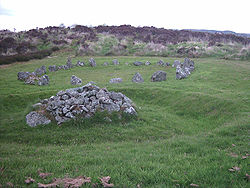Beaghmore

Beaghmore is a complex of early Bronze Age megalithic features, stone circles and cairns in the townland of Beaghmore, 8½ miles north-west of Cookstown in Tyrone, on the south-east edge of the Sperrin Mountains.[1]
The stone circles, alignments and cairns of Beaghmore are in state care.[2]
Sites
- Cairns:
- Stone circles, alignments and cairns, H684842
- Bradley’s Cairn (Round cairn with standing stones), H68308401;
Cairn and alignment, H68638431
All these are Scheduled Historic Monuments.



Name
The name of the place is from the Gaelic language. Some documents suggest that Beaghmore translates into English as 'the moor of the birches' but if so, it is the child of two tongues, as there is no Irish word for moor that sounds like the English word ‘moor’. Mackay's Dictionary of Ulster Place-names says that it is from an Bheitheach Mhór, meaning "big place of birch trees".[3]
There are no trees though: the area might once have been woodland but it was cleared by Neolithic farmers long before the Gaelic language gave it a name.
Excavation
The site was discovered by George Barnett[4][5] in the late 1930s during peat cutting when 1,269 stones were uncovered, [3] and partially excavated in 1945–1949 when it was taken into state care. It was also excavated again in 1965. Investigation of the site and the surrounding bog indicate that the area was occupied since Neolithic times through the Bronze Age. The stone circles and cairn are attributed to the earlier part of the Bronze Age c. 2,000–1,200 BC. It is possible that the full extent of the complex has not yet been revealed and further stones and cairns may still lie hidden in the adjacent peat.[1] Hearths and deposits of flint tools were discovered and have been carbon dated to 2900-2600BC. Several of the stone rows run over the tumbled walls of field structures which also date from the Neolithic period. Excavation of one of the cairns revealed a polished porcellanite axe, which may have originated from the Tievebulliagh axe factory, some 70 miles away in County Antrim. The largest cairn featured a central pit containing an oak branch.[3]
Features
There are seven low stone circles of different sizes, six of which are paired, twelve cairns and ten stone rows. The circles are between 10 yards and 20 yards in diameter, and are associated with earlier burial cairns and alignments of stone rows lead towards them. The stones are small with few more than a fot and a half in height and the circles are distorted, suggesting they are related to kerbs surrounding some megalithic tombs.
The singular circle is distinguished from the paired circles by its slightly larger stones. It is also unique in that the interior of the circle is filled with more than 800 small stones which have been placed upright within the circle and are known as "the dragon's teeth". Most of these circles have small stone alignments touching them at a tangent. The site also includes a dozen small stone cairns, frequently covering a cremation burial. Each of the three pairs of stone circles have a small cairn placed in between.[1]
A typical feature of the stone rows is a high and low arrangement where short rows of tall stones run beside much longer rows of small stones.[3] The stone rows radiate from the circles in a roughly north-east direction.[6]
The site also consists of low banks of small stones running below, and possibly pre-dating, the other structures which may have been field walls in the Neolithic period. Excavation has revealed that the site overlays a Neolithic cultivation site, and it is thought that the stones may have been erected in response to deteriorating soil fertility and the encroachment of peat.[7] Following excavation a system of drainage channels had to be laid to prevent the stones from being reclaimed once again by the bog.[1]
Function
Possibly the site could mark a focal point for religious and/or social gatherings. Some archaeologists believe that the circles have been constructed in relation to the rising of the sun at the solstice, or to record the movements of the sun and moon acting as observatories for particular lunar, solar or stellar events. Three of the stone rows point to the sunrise at the time of the solstice and another is aligned towards moonrise at the same period. However, most of the remains at Beaghmore do not indicate very accurate alignments upon specific astronomical features.[1]
Because of the number of stone cairns on the site it is possible that at least part of the function of the site was burial. Some cairns have been found to hold cremated human remains, occasionally contained in a small cist. But not all the cairns have burial remains and they could have had other purposes, or perhaps are simply accumulations of surplus stones.[1]
Outside links
- Location map: 54°42’14"N, 6°56’11"W
- OS map: H684842
- Beaghmore Stone Circles – Discover Northern Ireland
- Beaghmore Stone Circle – The Modern Antiquarian
- Beaghmore Circles and Alignments – Megalithic Ireland
- Beaghmore – Irish Megaliths
References
- ↑ 1.0 1.1 1.2 1.3 1.4 1.5 "Beaghmore Stone Circles". The Chrono Centre – Queens University Belfast. http://www.chrono.qub.ac.uk/local/tyrone/Beaghmore/. Retrieved 1 December 2007.
- ↑ "Beaghmore". Environment and Heritage Service NI – State Care Historic Monuments. http://www.ehsni.gov.uk/state_care_monuments_2007.pdf. Retrieved 3 December 2007.
- ↑ 3.0 3.1 3.2 3.3 "Beaghmore Stone Circle Complex". Megalithics. http://www.megalithics.com/ireland/beagmore/beagmain.htm. Retrieved 1 December 2007.
- ↑ "George Barnett". Ulster History Circle. http://www.ulsterhistory.co.uk/barnett.html. Retrieved 26 April 2014.
- ↑ "Beaghmore Stone Circles and Alignments and Cregganconroe Court Grave". Department of Environment (N. Ireland). http://www.doeni.gov.uk/niea/beaghmoreandcregganconroeeng.pdf. Retrieved 26 April 2014.
- ↑ "Beaghmore Stone Circles". Triskelle. http://www.triskelle.eu/attractions/beaghmorestonecircles.php?index=100.040.008.090. Retrieved 1 December 2007.
- ↑ "Beaghmore". The Megalithic Portal. http://www.megalithic.co.uk/article.php?sid=665. Retrieved 1 December 2007.
- McNally, Kenneth (2006). "Ireland's Ancient Stones" (Belfast: Appletree Press). ISBN 0-86281-996-2